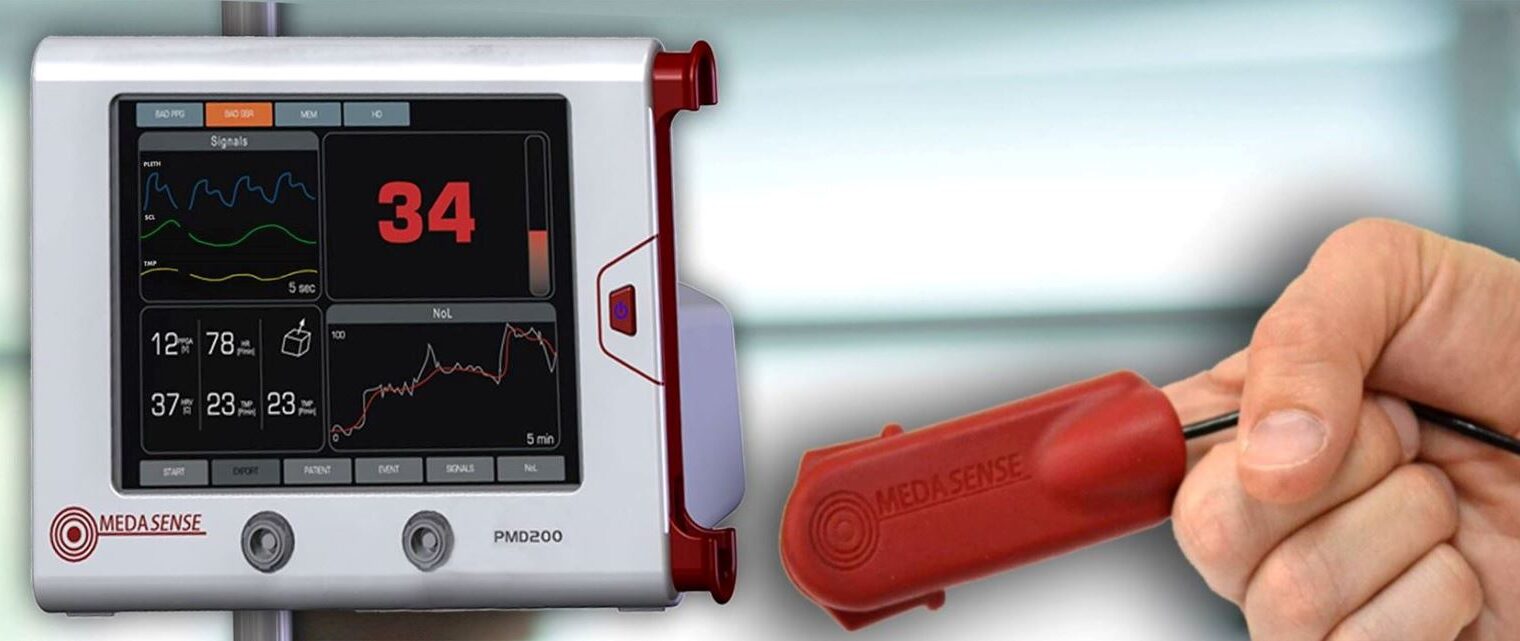Rate your pain on a scale of 1 to 10: Health professionals rely on this subjective method to assess pain. It’s not only imprecise but also impossible in many circumstances, such as when the patient is not communicating or under anesthesia.
Israel’s Medasense Biometrics is poised to solve the problem with a noninvasive system. The patented technology includes a finger-mounted sensor which records relevant physiological signs. Artificial-intelligence algorithms convert this data into a real-time, continuous pain index presented on a bedside monitor.
Medasense is expected to enter the European market in 2016, initially for use in the operating room, later in intensive-care and then in clinic and home settings. Pending additional regulatory approvals, the system eventually will be marketed worldwide and a mobile version will be developed.
The need for objective, accurate pain assessment is acute. In the United States alone, an estimated 40 percent of the 30 million surgical patients each year experience severe pain after surgery, and one in 10 suffers side effects from pain medication. In addition, some 17,000 people die every year from painkiller overdoses.
Accordingly, Medasense is creating a buzz. The company won the Israel Advanced Technology Industries’ WOW Competition in the medical device category for the most innovative startup last May, and was chosen by MedTech Strategist magazine as one of the “Start-Ups to Watch” in its September 2015 issue.
CEO Galit Zuckerman tells ISRAEL21c that the Medasense technology could lead to better pain management, clinical outcomes and cost reduction.
A robust system
Before founding the company in 2008, Zuckerman led a team of algorithm engineers at Applied Materials. “I enjoyed my work but felt a calling to do something in the medical field,” she explains.
Her mother is a surgical nurse, so the idea for pain-assessment technology came from years of conversations around the family dinner table — as well as Zuckerman hearing from a biomedical engineer friend about the phenomenon of people waking up during surgery.
After discussions with doctors including Elon Eisenberg, director of the multidisciplinary Pain Relief Unit at Rambam Medical Center in Haifa, and Itay Gur-Aryeh, director of the Pain Clinic at Sheba Hospital at Tel Hashomer, Zuckerman discovered that current methods for assessing pain are subjective. It made sense for her to apply her previous experience to the challenge of introducing technology to this field.
“We started with an idea and a presentation, and then spent three or four years developing the basic technology in the technology incubator program of the Israeli Office of the Chief Scientist,” says Zuckerman.
The company is financed and supported by private investors and by Medoc Advanced Medical Systems, which hosts Medasense in its Ramat Yishai headquarters near Yokneam in northern Israel. The units are assembled there as well.
Today, three other companies are developing similar products — GE Healthcare and two European startups — but Zuckerman says the technology is different in each case and that Medasense is the only one measuring multiple physiological parameters such as sweating and changes in heartrate and blood volume.
“We integrate those parameters and more, so we’ll have a more robust and sensitive system that can provide a solution in many different settings,” she says.
Validation studies
Clinical studies of the Medasense system have been going on for the past five years in Israel, the United States and The Netherlands. In September, the journal Anesthesiology published results of a trial led by anesthesiologist Albert Dahan at Leiden University Medical Center in Holland. This is in addition to two other articles published in scientific journals on two previous studies of the company, with additional publication in review on another completed study.
This study validated the superiority of the pain index generated by Medasense over current methods of pain assessment, allowing doctors to identify and differentiate painful events in surgery and to optimize pain treatment in the 72 patients involved in the trial.
“It is clear that current pain assessment approaches in the operating room are limited,” said Dahan. “These results add to the growing body of clinical evidence supporting the validity of the Medasense pain index (called NoL) as a decision-support tool to assist anesthesiologists.”
Zuckerman says that Medasense is continuing to conduct additional trials in different settings and is awaiting results of other study. Meanwhile, she is confident that “five years of research suggest it’s more accurate than any other assessment available.”
For more information, click here.














